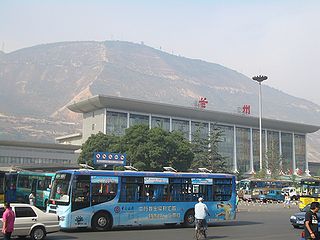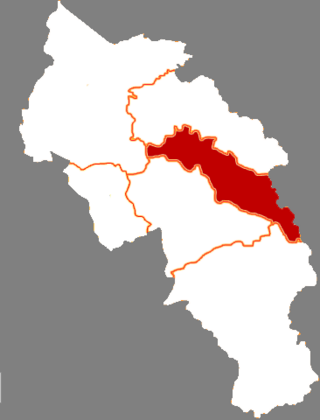
Shou County or Shouxian is a county in the north-central part of Anhui Province, China, and is located on the southern (right) bank of the Huai River. It is the southernmost county-level division of the prefecture-level city of Huainan. Its population is 1,280,000 and its area is 2,986 km2 (1,153 sq mi). It is a National Cultural and Historical City. The jurisdiction of Shou County was transfer from Lu'an to Huainan.
Longxi is a county under the administration of the prefecture-level city of Dingxi in the southeast of Gansu Province, China.

Lintao County simplified Chinese: 临洮县; traditional Chinese: 臨洮縣; pinyin: Líntáo Xiàn) is administratively under the control of Dingxi, Gansu province, China. In ancient times, Lintao was centered on present day Min County.

Min County or Minxian is administratively under the control of the prefecture-level city of Dingxi, in the south of Gansu province, China. In ancient times, it was known as Lintao County due to its location along the Tao River. It was founded as Minzhou (岷州) in 544, named after the Min Mountains in the south of the county. The county received its present name in 1913. In 1985 it became subordinate to Dingxi. Min county is well known by Angelica sinensis which is a Chinese traditional medicine.

Gangu County is a county in the southeast of Gansu province, China. It is under the administration of Tianshui City and is the most populous county in Gansu. Its postal code is 741200, and in 1999 its population was 570,318 people.

Qinzhou, formerly romanized as Tsinchow, is a district and the seat of the city of Tianshui, Gansu province, China. It is named for its former position as the seat of the medieval Chinese province of Qinzhou. Before 2005 it was called Qincheng District. It is the political, economic and cultural center of Tianshui.

Maiji District is a district of the prefecture-level city of Tianshui in the southeast of Gansu Province, China, bordering Shaanxi Province to the east. It is best known for, and named after, the Maijishan Grottoes. Before 2005 it was called Beidao District.

Jingyuan County is a county in the east of Gansu Province. It is under the administration of Baiyin City, and consists of two separate tracts of territory to the north and south of Pingchuan District. The northern tract borders Ningxia to the north. The southern area consists of an irrigated area around the Yellow River and the northern area is semi-arid highlands.

Yuzhong County is a county of Gansu Province, China, it is under the administration of the prefecture-level city of Lanzhou, the capital of Gansu, one of 58 counties of Gansu. Its postal code is 730100, and its population in 2019 was 560,000 people.

Huan County or Huanxian is an administrative district in eastern Gansu province, China at the junction of three provinces: Gansu, Shaanxi to the northeast, and Ningxia to the west and northwest. It is under the administration of the prefecture-level city of Qingyang.

Chengguan District is one of 5 districts of the prefecture-level city of Lanzhou, the capital of Gansu Province, China. It is located mostly on the southern side of the Yellow River, and includes the downtown Lanzhou. Both the Gansu provincial government capitol and that of Lanzhou prefecture-level city are located within the district. The Lanzhou Railway Station is also located in this district.

Pingchuan District is a district of the city of Baiyin, Gansu province, China. It is located about 65 km northeast of Baiyin city centre. The district was established in 1985, being part of Jingyuan County before then.
Huating is a county-level city, formerly Huating County, in the east of Gansu province, China, bordering Ningxia to the northwest. It is under the administration of the Pingliang City. Its postal code is 744100, and in 1999 its population was 176,941 people.

Mian County or Mianxian is a county of Hanzhong, in the southwest of Shaanxi province, China, bordering Gansu province to the northwest. Its area measures 2,406 km2 (929 sq mi), and its total population as of 2020 was 429,000 people. During the Qin and Han dynasty it was known as Mianshui (沔水). In 1964 it was renamed to Mianxian with a homophone character for Mian, to avoid the use of uncommon characters in place names. In 2020, the county government requested the name of the county to be changed to Mianzhou (沔州市), pending central government approval. Previously the government requested to use the name Dingjunshan City, but this was denied by the central government.

Li County or Lixian is an administrative division of the prefecture-level city of Longnan in southeastern Gansu, a northwestern province of China. The 2010 Chinese census found a population of 458,237, a decline of around 25,000 from the year 2000 but still placing it second in size within its prefecture.
Heping is a town of Yuzhong County, Lanzhou, Gansu, China. It is informally known as Lanzhou's college town, with several college and university campuses located in the town.

Huishi is a town of Huining County, Gansu, China. It is also the county seat. The town had a population of 136,000 in 2019. In October 1936, the Red Army met in Huishi to celebrate the end of the Long March. The town is named after this event, its name literally means 'meeting of the armies'.
A'gan is a town of Qilihe District, Lanzhou, China. It is located in a mountainous area 20 kilometers south of Lanzhou's urban area. A'gan is located near a mountain pass on the route between Lanzhou and the historically important city of Lintao. The name A'gan is thought to be derived from an ancient folk song of the same name.
Nanping is a town of Lintao County, Dingxi City, Gansu, China.
Yongxing is a town of Li County, Gansu, China. The population is 24,000. It is located about 25 km away from the county seat. The town's government seat is Yongxing village. The town was established in 1952.















